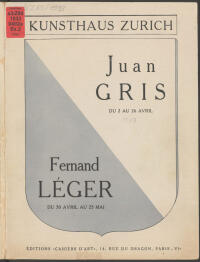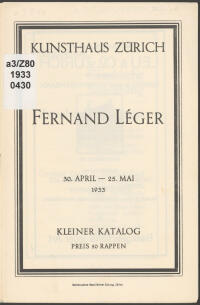Fernand Léger
30.04.1933 – 25.05.1933
Location Kunsthaus.
Location Kunsthaus.
Eye-Catching, Reduced, High-Contrast: Fernand Léger
As early as 1925 the Kunsthaus Zurich had shown works by the painter, graphic artist, sculptor, ceramicist, and designer, Fernand Léger (b. 1881 in Argentan, d. 1955 in Gif-sur-Yvette near Paris) in a group show. A three-artist exhibition originally planned for 1932, showing Picasso, Braque, and Léger. mutated into a solo exhibition for Picasso, so that Léger was not honored until a year later: In 1933 the Kunsthaus presented 100 paintings and 50 drawings. Watercolors and graphic prints from more than two decades. They included, for example, the painting “la ville” (1919), which is today in the Philadelphia Museum of Art and with its impressive dimensions of 231 × 297 cm was the large format in the exhibition.
According to Wilhelm Wartmann, the Director of the Kunsthaus at that time, Fernand Léger, “finds an escape from the traditional image with a subject in a cult off the single object. […] Léger makes the isolated object, the defined and visible object, the “subject” of the picture. In this, the contrasting colors play a central role. “The colors are liberated from their meaning and are raised to a unprecedented level of intensity.” Two years after Zurich, Léger’s characteristic cylindrical forms and the machine-inspired technoid language of forms were also presented to the public in a solo exhibition in New York’s MOMA. After the war, Léger was then honored posthumously in the first three documenta in Kassel as one of the most important representatives of modernity.
In general, the press responded to the Zurich exhibition from reservedly to dismissively. In the Schweizer Maler- und Gipser Zeitung on understood Léger in the context of New Construction as a fundamentally modern and positively revolutionary artist, although the question arose of how his modernity was to be conveyed to a wider public. In the Tages-Anzeiger, the historian Berthold Fenigstein described his ambivalent reaction to the artist. The reviewer took pleasure in the fresh coloring, but later noticed “that the pictures say less to one the more often one sees them.” And: “The exhibition too much of a good thing, or, let’s say, of the same thing.” A dozen of Léger’s works would have been enough.”
With the exhibition appeared a catalog with a list of works.
[Peter Stohler]
And: “The exhibition too much of a good thing, or, let’s say, of the same thing.” A dozen of Léger’s works would have been enough.”
25 days
1 Artist
1 Artist

1/2
exhibition catalog

2/2
exhibition catalog
1/2